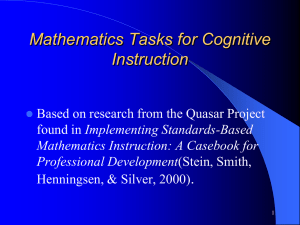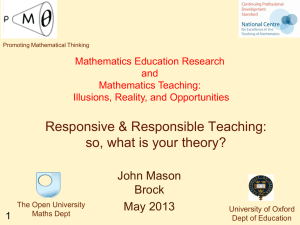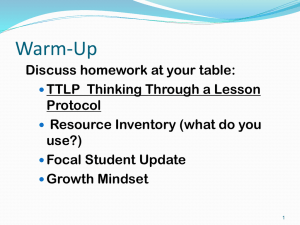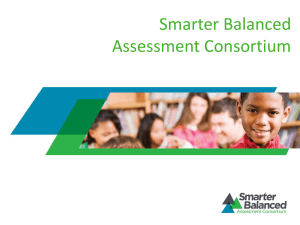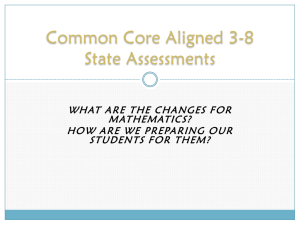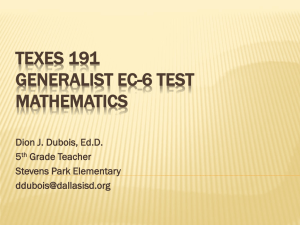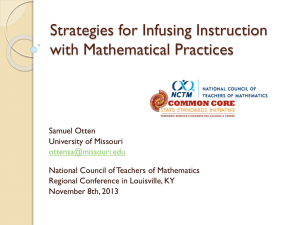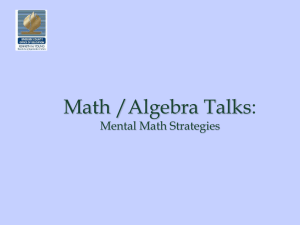Kentucky Core Academic Standards: Mathematics
advertisement
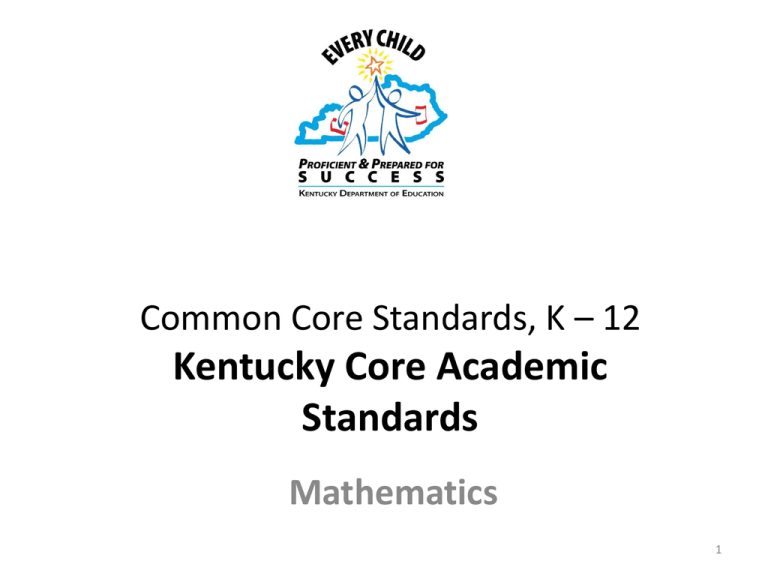
Common Core Standards, K – 12 Kentucky Core Academic Standards Mathematics 1 What do we mean by: Understanding Mathematics? Jake is a Genius • Each person get 4 post-it notes and silently read pages 3, 4, & 5, and the bottom of page 8. – On the 1st post-it write down a couple of the most important ideas in the Introduction (pg 3), – On the 2nd post-it write down a couple of the most important ideas about Understanding Mathematics (pg 4), – On the 3rd post-it write down a couple of the most important ideas about How to read the grade level standards and what the standards do and do not mean (pg 5), – On the 4th post-it write down a couple of the most important ideas about Connecting the Standards for Mathematical Practice to the Standards for Mathematical Content (pg 8). 2 What do we mean by: Understanding Mathematics? • When everyone has finished reading & jotting down their ideas, share your ideas from each post-it by having each person read one idea for each topic. Take turns letting a different person be the first to share their ideas for each of the topics: – Introduction – Understanding Mathematics – How to read the grade level standards & what the standards mean – Connecting the Standards for Mathematical Practice to the Standards for Mathematical Content How did this process clarify your thinking about what was read? 3 Standards for Mathematical Practice The standards for mathematical Practice are important “processes and proficiencies” and describe varieties of expertise that mathematics educators at all levels should seek to develop in their students. See page 6. They are based on ideas important to mathematics education from – the NCTM process the strands of mathematical proficiency specified in the standards of: National Research Council’s report Adding It Up: problem solving, adaptive reasoning, reasoning and proof, strategic competence, communication, conceptual understanding, (comprehension of mathematical concepts, operations and representation, and relations), connections. procedural fluency, and (skill in carrying out procedures flexibly, accurately, efficiently and appropriately), productive disposition. (habitual inclination to see mathematics as sensible, useful, and worthwhile, coupled with a belief in diligence and one’s 4 Standards for Mathematical Practice – pgs 6-8 • Silently read the mathematical practice assigned to your group and highlight your MIPs. • On chart paper, your group will represent your mathematical practice in words and pictures. • Be prepared to share out. 5 Standards for Mathematical Practice – pgs 6-8 • Cut out your foldable and write one mathematical practice on each front flap. • As each group presents their mathematical practice, use your foldable to record ideas about the meaning of each practice. foldable 6 7 Middle School Landscape • Using the topics assigned to your group, identify where the topic starts and stops in the CCSS using the Cluster & Domain Progression handout. • Discuss with your group any differences you notice between the progression of your topic in the CCSS and the KY POS. • Be prepared to share your findings. 8 High School Landscape • Use the suggested CCSS Pathway to compare the content of this course to the table of contents of your assigned text. • Discuss with your group any content differences you notice between the two. • Be prepared to share your findings. 9 10 Supplement Practices In what ways do the differences between the old and new arrangement of content topics impact any two of these areas? Interventions Content Knowledge Assessments 11 Analyzing Cognitive Demand • All mathematical tasks are not created equal. • As we solve two problems dealing with area, we will look for similarities and differences between the two. • Afterwards, we will sort new and different problems into low and high level tasks. 12 Why instructional tasks are important? Comparing Two Mathematical Tasks: 1. Martha’s Carpeting Task 2. The Fencing Task 13 Martha’s Carpeting Task: Solve on your own, then discuss with your table group. Martha was recarpeting her bedroom, which was 15 feet long and 10 feet wide. How many square feet of carpeting will she need to purchase? 14 Martha’s Carpeting Task Solution Strategies: Using the Area Formula A=lxw A = 15 x 10 A = 150 square feet Drawing a Picture 10 15 15 The Fencing Task: Solve on your own then discuss with your table group. Ms. Brown’s class will raise rabbits for Their spring science fair. They have 24 feet of fencing with which to build a rectangular rabbit pen to keep the rabbits. – If Ms. Brown’s students want their rabbits to have as much room as possible, how long would each of the sides of the pen be? – How long would each of the sides of the pen be if they had only 16 feet of fencing? – How would you go about determining the pen with the most room for any amount of fencing? Organize your work so that someone else who reads it will understand it. 16 The Fencing Task Solution Strategies: Diagrams on Grid Paper 17 The Fencing Task Solution Strategies: Using a Table Length 1 2 Width 11 10 Perimeter 24 24 Area 11 20 3 4 5 9 8 7 24 24 24 27 32 35 6 6 24 36 7 5 24 35 18 The Fencing Task Solution Strategies: Graph of Length and Area 40 Max 35 30 Area 25 20 15 10 5 0 0 1 2 3 4 5 6 7 8 9 10 11 12 13 Length 19 Comparing Two Mathematical Tasks •How are Martha’s Carpeting Task and the Fencing Task the same and how are they different? 20 Similarities and Differences Similarities • Both are “area” problems • Both require prior knowledge of area Differences • The amount of thinking and reasoning required • The number of ways the problem can be solved • Way in which the area formula is used • The need to generalize • The range of ways to enter the problem 21 • Would both the Carpet & Fencing tasks likely be assigned by both a teacher who accepted the student claim and a teacher who explored the claim? • Which task, Carpet or Fencing, would help the student who made the claim to actually understand why her claim is 22 Mathematical Tasks: A Critical Starting Point for Instruction Not all tasks are created equal, and different tasks will provoke different levels and kinds of student thinking. Stein, Smith, Henningsen, & Silver, 2000 23 Mathematical Tasks: The level and kind of thinking in which students engage determines what they will learn. Hiebert, Carpenter, Fennema, Fuson, Wearne, Murray, Oliver, & Human, 1997 24 Learning Targets Tasks, Problems, Assignments 25 Mathematical Tasks: There is no decision that teachers make that has a greater impact on students’ opportunities to learn and on their perceptions about what mathematics is than the selection or creation of the tasks with which the teacher engages students in studying mathematics. Lappan & Briars, 1995 26 Mathematical Tasks: If we want students to develop the capacity to think, reason, and problem solve then we need to start with high-level, cognitively complex tasks. Stein & Lane, 1996 27 Task Sort • Being able to sort tasks according to cognitive demand allows teachers to better match tasks with learning targets. • As you sort through these tasks: – Separate them by “cognitive demand” – Map all applicable standards/ practices to these tasks 28 Demonstrating Competency Does this always look the same? When does a teacher need to consider what this looks like? How does this impact teaching and learning, assessment, and interventions? 29 Demonstration of Learning Teaching and Learning Assessments Standards/ Targets 30 Fortune Cookie • Each team receives an envelope. • One person draws a question, and makes one statement about the topic, then passes it on. • The next person adds their statement or responds to the previous statement. • When everyone has responded to the first statement, another person draws from the envelope and repeats the process. 31 32

